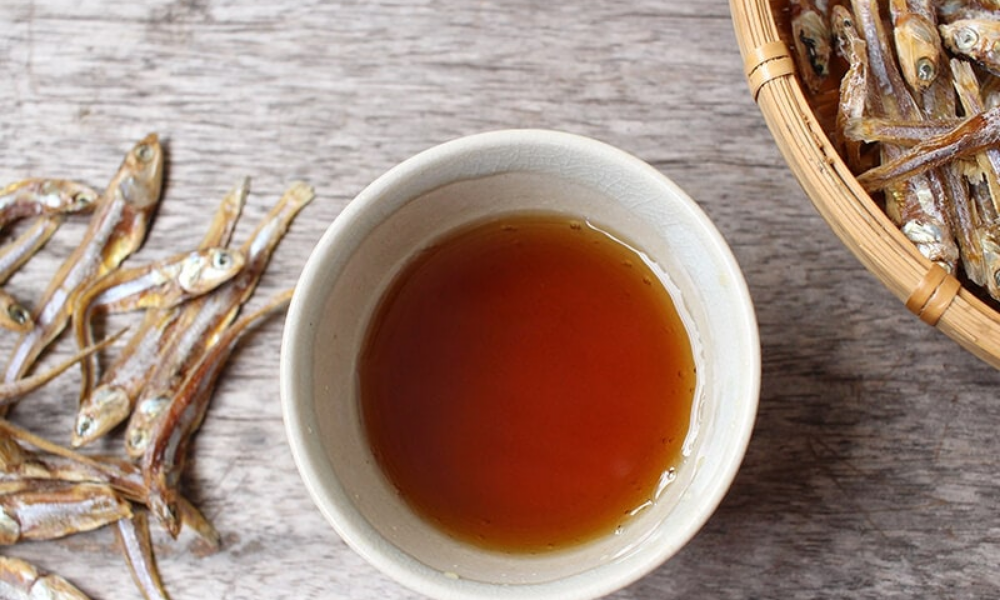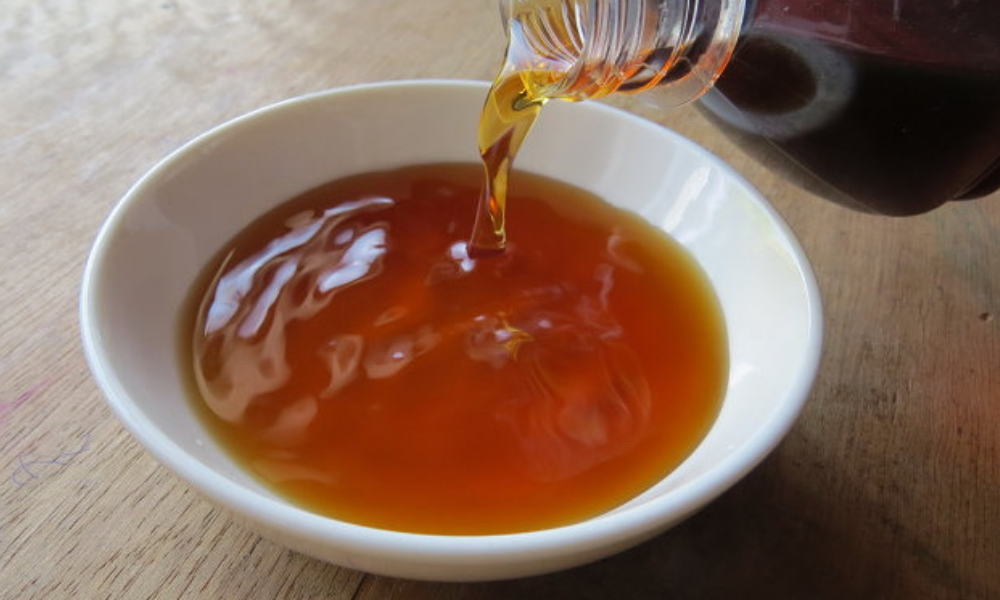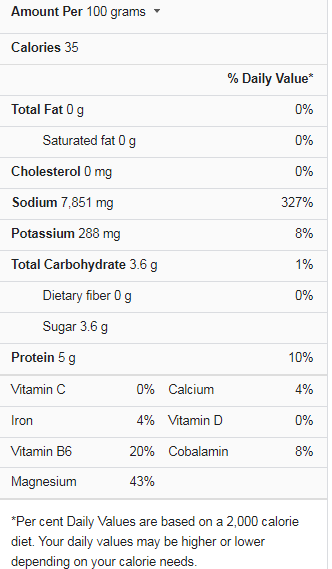Fish sauce is naturally fermented through the ageing process of fish and salt, and several amino acids are produced during the hydrolysis process. In particular, amino acids are broken down into smaller bits by the enzyme system found in fish intestines, which makes it easier for your body to absorb them directly.
Studies have shown that the five essential amino acids for the body, valine, Isoleucine, phenylalanine, methionine, and lysine, are present in traditional fish sauce. Valine specifically aids in body regulation, sleep support, and increased hunger, and Isoleucine supports health recovery during strenuous exercise and aids in blood sugar monitoring.
It is specifically created to be suited for children’s tastes and to support children’s overall development. Children who lack lysine may struggle with anorexia, sluggish growth, and a lack of digestive enzymes, among other problems. However, cooking has a very high risk of destroying this vitamin. As a result, the naturally fermented lysine found in fish sauce is both valuable and useful.
Fish sauce improves the flavour of meals without adding a fishy flavour. In place of soy sauce, we use fish sauce. The flavour is unique but fantastic. We often add it to broths and soups to enhance flavour and nutrients, and I even use it in place of salt when I’m preparing meat. Fish sauce offers vital elements that will improve your diet rather than the issues with soy products. The vital minerals and nutrients in fish and organs are concentrated in fish sauce, which has undergone more fermentation. In addition to vitamins A and D, this also includes iodine and other thyroid-supporting chemicals.
What is Fish Sauce?
Fish or krill salted and fermented for up to two years are used to make fish sauce, a liquid condiment. East Asian and Southeast Asian cuisines employ it as a basic seasoning, particularly those of Myanmar, Cambodia, China, Indonesia, Laos, Malaysia, the Philippines, Taiwan, Thailand, and Vietnam. Since the Roman era, the West has utilized fish sauces linked to garum.
It has gained popularity among chefs and home cooks worldwide due to its ability to provide a savoury umami flavour to foods. The glutamate concentration of fish sauce is what gives it its umami flavour. Fish sauce is often used as a foundation for dipping sauces as a flavour during or after cooking. Even though soy sauce and fish sauce have quite different flavours, some Westerners view soy sauce as a vegetarian substitute for fish sauce.
Fish Sauce Nutrition Facts
Health Benefits of Fish Sauce
Fish sauce has more vitamins, including B1, B2, PP, and especially B12, due to the natural brewing process using fish and salt. The amount of vitamin B12 in fish sauce is estimated to be five micrograms per 100 ml. It is very helpful in hematopoiesis, maintaining a healthy neurological system, and promoting more effective cell division. In particular, pregnant women need vitamin B12 to increase the likelihood of a healthy delivery and avoid birth abnormalities.
International guidelines state that pregnant or breastfeeding women must consume 2.2 mcg of B12 daily. For the average person, the body requires 2.4 mcg to operate correctly. More crucially, since the body cannot produce vitamin B12 on its own, it must be obtained from the traditional fish sauce we eat daily. Additionally, other food sources include B12, yogurt, beef, and others.
Supplement your Diet with Iron
The fish sauce contains iron, a valuable component that is also one of the vital micronutrients for proper body operation. According to nutrition experts, there will be approximately 10mg of natural iron in every 10ml of pure fish sauce made from anchovies. The prevalence of iron deficiency anemia among women in our nation has decreased over time due to the widespread usage of traditional fish sauces. Premature delivery or maternal and infant mortality risk would be reduced.
The highland ethnic groups’ folklore suggests that pregnant women are more likely to benefit physically from foods seasoned with fish sauce, such as braised meat and fish stock. They have good skin since they’ve received supplements with the body’s required amount of iron.
Provide a Powerful Source of Omega 3
Fish sauce has a high omega-three concentration because it is a naturally hydrolyzed product. Anchovies with fish sauce are rich in omega 3, and Omega 3 content per 100g of anchovies is 2113 mg.
In addition to being one of the body’s necessary fats, this one also helps with blood fat reduction, heart health, and brain growth. The development of children’s nerves and vision depends heavily on omega 3, and fish sauce is the most recommended natural source of omega 3 for people who rarely consume fish.
As can be seen, fish sauce is a fantastic source of natural nutrients and may be used as a dipping sauce or spice in cooking. These advantages are exclusive to authentic fish sauce.
Organically fermenting anchovies and pure salt produce the fish sauce for 12 months in wooden barrels. This process preserves the fish sauce’s vital ingredients while giving it a deep, sweet flavour of fish meat. The ideal origin fish sauce for Vietnamese health
Keep Body Warm
Scientists claim that fish sauce has a high natural protein content due to the hydrolysis of the fish and salt, making it an excellent energy source for the body. Therefore, skilled divers frequently consume a tiny amount of pure fish sauce for body warmth maintenance before entering the water.
Delicious Fish Sauce Helps to Eliminate Fishy Odors
In addition to giving a dish a rich flavour and perfume, the fish sauce also helps eliminate the fishy smell that permeates internal organs.
Light pure fish sauce with warm water, the food can be washed to remove the strong odour without losing its natural flavour. By doing this, the unpleasant smell would be eliminated, increasing how wonderful the food would be.
Is Fish Sauce Good for your Heart?
Pour some oil into a wok or a big pan. Use high heat for a brief period when stir-frying to prevent overcooking, which destroys vital nutrients and ruins the texture. Cook the vegetables last after the protein. For an increase in flavour, add your favourite spices. In no time, you’ll have a low-fat, low-sodium, fibre- and protein-rich, vitamin- and mineral-rich dinner on the table. If the meal starts to dry up, add some reduced-fat broth to the pan rather than more oil to keep it going. The extra oil won’t make you obese. Your pantry ought to have Asian flavours.
These flavour-enhancing chemicals will replace MSG, excess sodium, and extra sugar to boost flavour. The flavour of other ingredients is enhanced by fish sauce rather than salt. In addition to salt, the fish sauce also has protein, heart-healthy omega-3 fatty acids, and other vitamins and minerals. Verify that the components only include fish, salt, and sometimes water. A staple of Asian cooking, soy sauce is made from fermented soybean paste. Because Americans consume enough salt as it is, use a low-sodium soy sauce and keep portions in check. Red chilli sauce, prepared from garlic and red chillies, is a source of vitamins A and E.
According to a study, ground chiles provide heat to any dish and aid in reducing inflammation and boosting immunity. Spices are combined to create curry paste, which has a potent flavour. For instance, research has demonstrated the anti-inflammatory and antioxidant benefits of turmeric. Iron and potassium-rich lemongrass are prominent ingredients in Thai cooking. Coriander (cilantro) leaves are a good source of fibre-rich nutrients and vitamins and minerals. Dry components: Especially in Chinese cuisine, dried mushrooms, prawns, and clams are typical ingredients in Asian meals.
Which is Healthier, Fish Sauce or Soy Sauce?
Since the time of the ancient Greeks and Romans, when it was known as garum, fish sauce has existed. Garum came in various flavours, was made from various fish, and occasionally included extra ingredients like grape concentrate. The Romans used garum to season practically all their meat, fish, poultry, and vegetable dishes since it was so important to their health.
The ancient Romans and Greeks also served fish sauce as a dipping sauce with each meal. Since it is commonly used as a spice in Thai and Vietnamese cuisine, most people identify fish sauce with those two countries. Contrary to popular belief, fish sauce is prepared from fermented fish, not rotting fish. Fish sauce is made from many tiny fish’ entire bodies (including all organs).
Small fish are usually anchovies, put in salt-filled containers and allowed to ferment for a while. Filtering the mixture yields a clear, light brown liquid that includes all the nutrients in the complete fish and those that fermentation adds. The best fish sauce is undiluted. The nutritional value of the sauce is decreased, and it becomes excessively salty when salt water is used to thin out substandard versions of the sauce.
The fermentation process used to create traditional soy sauce is comparable. I think soy sauce was created as a less expensive alternative to fish sauce; however, I can’t prove it. The Weston A. Price Foundation advises the Thai Kitchen brand fish sauce, and I use it. It is delicious and nutritious. Additionally, it is gluten-free.
Is Fish Sauce Poisonous?
There are two main categories of arsenic: organic and inorganic. Arsenic can be found in a wide range of chemical forms. According to Tran Thi Dung, a senior expert at the Vietnam Institute of Fishery Economics and Planning, organic arsenic, naturally present in fish and other seafood, is non-toxic, whereas inorganic arsenic is the most hazardous to human health. To keep the fish sauce tasty and fresh after opening, carefully cover it.
The amino acids in the fish sauce will change if it is kept in the refrigerator. Fish sauce is unquestionably a wonderful flavour, filling, and useful nutritional addition that is reasonably priced. Use the fish sauce regularly to enhance your family’s meals’ flavour and nutritional value.
Fish sauce is a delicious soy alternative that is also good for your health. The books Tender Grassfed Meat: Traditional Ways to Cook Healthy Meat and Tender Grassfed Barbecue: Traditional, Primal, and Paleo are written by Stanley Fishman.
What Happens if you Consume an Excessive Amount of Fish Sauce?
Your Southeast Asian cuisine could benefit from the zest that fish sauce, a well-liked bottled mixture of fermented fish and salt, can bring. But according to a recent Australian study, consuming too much fish sauce can increase blood pressure and jeopardize your heart health.
Of the 157 popular Asian-style sauce products bought from Australia’s four major supermarkets between 2010 and 2018, research revealed that fish sauce was the saltiest.
The study found that just one tablespoon of the common condiment provides 96% of the recommended daily salt consumption. An amount of soy sauce Ten percent of the salt we consume daily comes from plastic fish packets like the ones you put on sushi.
One tablespoon of regular soy sauce contains 61 percent of the daily recommended salt intake, compared to a little soy sauce plastic fish package used to top sushi rolls that contain only 10% of it.
Why is Fish Sauce so Delicious?
One of the few ingredients, fish sauce, gives food an instant, spectacular flavour boost. It is simultaneously sweet, salty, fishy, and foul in a prismatic tsunami of flavour. What exactly is fish sauce, though? Whether we knew it or not, we’ve all had it. Pad Thai, anyone? However, that doesn’t mean we know what’s inside.
It’s a fish. Fish sauce is a suitable nickname. As advertised, it obtains a significant amount of flavour from fish, but the fish sauce doesn’t magically develop when you mash a fish around. Fish fermented for a few months to several years produces the best flavour.
Anchovies and other small fish are salted and kept in large barrels. Natural bacteria break down the fish, producing a savoury, salty liquid with a fishy flavour. That is fish sauce, my friends. For thousands of years, people have used fermentation to enhance the flavour of anything from fish to meat to beans to vegetables.
Fermented fish sauce is used or has been used by numerous cultures, from the Greeks to the Chinese, but we most frequently associate it with Southeast Asian cuisine. It’s a crucial component in dishes like pad thai, green papaya salad, larb, Vietnamese marinated meats, and stir-fries.
Conclusion
Fish sauce is a staple condiment for every daily Southeast Asian meal. Fish sauce is a flavorful condiment that is also packed with nutrients. One of fish sauce’s most noticeable advantages is its high concentration of necessary amino acids, which help with sleep and prevent anorexia. Amino acids also help to improve digestion and metabolism.
The fish sauce is also abundant in omega-3 fatty acids. Omega 3 fatty acids improve heart and brain function, lower cholesterol, and lower blood pressure. Fish sauce’s high iron level is highly beneficial to expecting women. Foods seasoned with fish sauce have lower rates of infant death and preterm birth. Vitamin B12 is further necessary for a healthy pregnancy.




